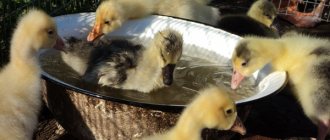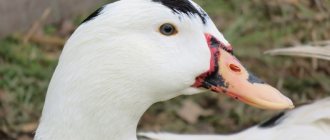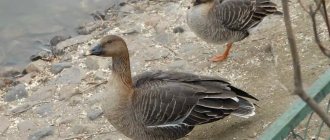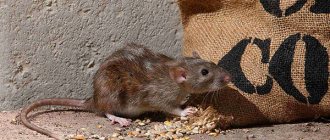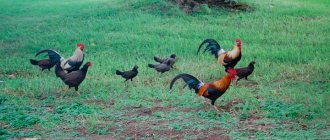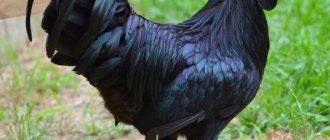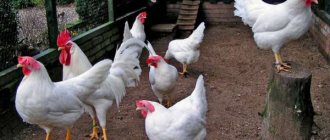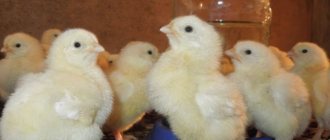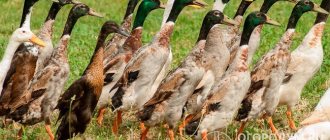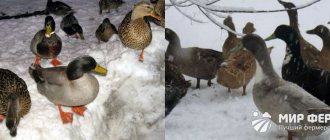Some poultry farmers call large gray geese “cardinals,” perhaps due to the common idiom “gray cardinal” or emphasizing the large dimensions of purebred individuals. Outwardly, they are very similar to one of their ancestors - the ordinary wild gray goose. Birds are completely unpretentious, therefore they are considered very profitable for breeding “for meat” in households or on farmsteads. This breed is widespread in Russia, as well as in other countries of the post-Soviet space.
Birds feel great on grazing, so caring for both adults and young animals does not cause much trouble.
A brief description of the Large Gray geese, their main species characteristics and features are given in the table:
| Parameter | Characteristic |
| Class | Birds |
| Genus | Geese (Anser) |
| Breed | "Large gray" |
| Productivity type | Meat-sucking |
| Plumage color | Main – gray; belly and wing tips are white |
| Feed Conversion | High |
| Live weight of adults | Males - 6-9.5 kg; females – 5.5-8.5 kg |
| Egg production per year | from 35 to 60 eggs |
| Egg weight | 160-200 g |
| Hatchability of young animals | 60-75% |
| Peculiarities | The breed is not autosexous; does not require a reservoir |
| Year of inclusion in the State Register of the Russian Federation | 1993 |
| Originators | Gosplemptitsa (Tambov region), LLC "Plempttice plant Blagovarsky" (Republic of Bashkortostan) |
Description of the breed
All details of the breeding of this breed are currently unknown. The work began in the 30s of the last century in Ukraine. Toulouse and Romen geese became the basis for obtaining a heavy breed of gray geese of the meat-and-fat type.
With the beginning of the Great Patriotic War, breeding geese, bred as a result of long work, were transferred to the Arzhenka state farm, located in the Tambov region, for preservation and breeding. There further selection work was continued: crossing Toulouse ganders and Romny geese and further selection for the characteristics of rapid gain of live weight and good egg production.
Goose menu
The diet is based on roughage (hay, grass) and grain; in winter, geese readily eat vegetables and silage.
In the summer, as soon as the grass grows, the livestock is released to pasture. Geese graze all day long, returning to the barn in the evening, where grain feeding awaits them. Depending on the richness of the pastures and the composition of the grass stand (cereals or legumes), the geese are fed a grain mixture (oats, barley, wheat) in the amount of 100–200 g per head. The richer the grass on the pasture (clover, alfalfa, sainfoin), the less additional grain they produce.
It is necessary to place a separate trough in free access, into which crushed eggshells, chalk, slaked lime, shell rock, and charcoal are poured. Mineral nutrition is necessary to maintain the health of the bird and the strength of the egg shells.
In winter, geese are given:
- hay in the form of chopped hay with particles up to 5 cm long - up to 300 g per head;
- mixed feed or grain mixture + premix - 200–250 g;
- fresh vegetables (carrots, beets, cabbage, pumpkin) or grass silage - up to 200 g.
It is necessary to ensure that breeding geese do not become fat, focusing their feeding on hay, vegetables and oats. In the last month before slaughter, fattening birds are allowed to feed mash with boiled potatoes, crushed corn, food waste (porridge, soups), and add cake or fuza.
Subspecies of greylag geese
Work carried out in two regions at once to improve the breed led to the creation of the Tambov (steppe) and Ukrainian (Borkovsky) subspecies of gray geese.
Borkovsky goose
Photo:
Large gray geese of this type were obtained from crossing ganders of the Toulouse breed with Romenskaya geese carried out over 3 years.
Three generations of geese obtained from such parents were again crossed with males of the Toulouse breed, and then the hybrids were bred “in themselves.” Young animals of the Borkov type were kept and fed on pasture, only concentrated industrial feed was introduced as additives.
The large gray breed of Borkovsky type geese is characterized by increasing egg production up to the fifth year of life.
Tambov steppe goose
This intrabreed type was bred by a single crossing of Toulouse ganders with geese of the Romny breed. Subsequently, the resulting crossbreeds were crossed “in themselves.”
To obtain a breed suitable for breeding in water-poor and steppe regions, the young gray geese obtained in this way were raised without ponds, on large pastures. Selection and selection of the most productive individuals made it possible to obtain large gray geese of the Tambov steppe type.
Subsequently, breeding stock was brought to different regions of the CIS, as a result of which the distribution area of these birds expanded significantly.
Today, gray geese are actively used in the breeding of highly productive breeds that are resistant to new climatic zones. The successes achieved in this regard contributed to a significant expansion of the range of greylag geese.
Feeding the goslings
Under maternal supervision, goslings do not need special care. The main thing is to follow the correct goose feeding regimen .
At first, these are mixtures of boiled eggs and herbs, cottage cheese and crushed corn or wheat, mixed with soybean or sunflower meal. After about a week, you can get used to root vegetables and cake. To prevent the nasal openings from becoming clogged, goslings should be given food in the form of wet, crumbly mash. When raising geese for meat, they are kept in a pen and fed concentrates with the addition of various greens. This makes it possible to achieve up to 4.5 live weight at the time of slaughter (9–10 weeks). In the first two months, goslings experience the most intensive growth. To gain 1 kg of live weight, a gosling needs 2–2.5 kg of grain and up to 9 kilograms of succulent feed.
In the future, maintenance does not make sense if you do not plan to create a goose family. Because the plumage will begin to change and stumps will appear on the carcass, as well as the growth rate will decrease and fat deposition will begin.
External characteristics
Large gray geese are strong and agile; they cover long distances on pasture. This breed has a wide body with deep, bulging pectoral muscles. Powerful, well-developed wings are pressed to the body.
Their strong legs are orange. The well-developed belly of the large gray goose has a double fold of fat. A thick, medium-length neck is crowned by a small, massive head.
These birds have a slightly flattened beak of a deep orange color, with a small pink spot at the end, and orange “rings” around the eyes.
The color of the plumage is predominantly gray, with a lighter shade on the chest and a darker shade on the wings and back. The plumage on the belly, lower body and tips of the tail feathers may be almost white. A “scaly” pattern is clearly visible on the back and wings.
Dense goose down is used in the production of outerwear, blankets and pillows. The strong feet of greylag geese are characterized by a rich orange hue.
The weight of a male large gray breed of geese is large, reaching 9 kilograms. Females are slightly smaller: their weight rarely exceeds 7 kilograms. With proper fattening, young animals gain a live weight of about 5 kilograms in just 9 weeks. This is a very high figure among meat-and-fat birds.
Advantages and disadvantages of the breed
Large gray geese, as a meat-fat breed, have a number of serious advantages.
High rate of biomass growth - one individual on a good diet gains 4-5 kilograms of weight in the first nine weeks of life. This allows them to be kept only in the summer and slaughtered for meat with the onset of cold weather.
Geese have relatively good fertility and maternal instinct.
Unpretentiousness in food, which allows you to save on keeping birds.
It is possible to breed gray geese without a pond.
These birds tolerate frost well. Therefore, in winter you don’t have to heat the poultry house much, which reduces the cost of maintaining the livestock.
Excellent health. Geese of this breed have high disease resistance.
The main disadvantage of the large gray breed of geese is the nature of the birds and their scandalousness. They often make noise, shout, and can provoke offenders into fights.
However, many breeders do not consider this a disadvantage. They call the “cockiness” of gray screamers as excellent guarding qualities. Thanks to the “fighting” disposition of geese, you can safely leave the flock on the pasture - these guys will not allow themselves to be offended.
Features of character and behavior
The gray goose is a flocking bird, and there is a strict hierarchy in the herd. Geese communicate not only through sounds of different frequencies and volumes.
There are certain body movements that signal danger. The flock reacts to them very quickly. The gray goose, unlike chickens and ducks, becomes attached to the person caring for it.
Geese are distinguished by vindictiveness and touchiness: at any opportunity they can take revenge. However, it is worth knowing that this bird does not rush at anyone without reason. Compared to chickens and ducks, geese are not so fussy, they behave calmly in the yard, they do not scatter to the sides, but stay closely together, which makes them easier to control.
Where to buy geese
Birds of the large gray breed are very popular, so purchasing them is not a problem. This can be done at one of the following nurseries.
| Name | Contact details |
| "Poultry yard" | Ukraine Online store https://keklik.com.ua/ 067-9183494, 095-1290482, 093-5648787 |
| "Goose Farm" | Moscow region, Chekhov district, Alferovo village. Tel. 8-965-178-38-71; 8-916-751-91-07; 8-929-654-43-65. https://goose-farm.rf/ |
| Nursery "Sibiryak" | Krasnoyarsk, 21 km. Yenisei highway, opposite the village. Roadside. Tel., 8-960-761-19-15. https://www.krasfermer.ru/ |
| Nursery of elite birds "Golden Pheasant" | Tula region, p. High> 8-962-276-71-11; 8-910-701-11-46; https://goldfaz.ru/ |
| "Nursery for breeding agricultural poultry" | Moscow “Gardener” (“Bird Market”), 14 km. MKAD (Belaya Dacha) 8(495)941-90-84;; 8-926-586-42-004 8-925-772-67-32. |
| "Blagovarsky Poultry Plant" | Republic of Bashkortostan, Blagovarsky district, village. Linguistically (34747) 2-19-8944; (34747) 2-19-98. https://blag-duck.ru |
Productivity and egg production
The large gray goose reaches sexual maturity at 7-12 months, later than other poultry. Affects the fertility and age of the bird: reaching a maximum of 3-4 years, it sharply decreases.
The egg productivity of the large gray breed of geese reaches 50-60 eggs per year. One egg weighs on average 160-180 grams. If the necessary conditions are created, chicks hatch from almost all eggs. The masonry is characterized by a viability of at least 75%.
How to feed?
We recommend reading our other articles
- Pear variety Sapphira columnar
- The benefits and harms of quail meat
- How to properly store onions in winter
- The best self-fertile cherry varieties
Feeding Large Gray geese
Dry food (grain, legumes) is used for feeding. This is the basis of the diet, and wet mash is an additive, since birds eat most of the greens while walking. They also need to include bran, cake, meal, grass flour, yeast, and mineral supplements in their diet. Chalk and gravel are poured into separate feeders; birds should always have access to them!
In summer, the basis of the diet is pastured greens. In the morning they give coarse food (grain), and in the evening - fresh mash of root vegetables, cake, bran.
In winter, it is recommended to give hay, steamed straw, silage, and root vegetables instead of greens. It is important that there is not enough fresh, juicy food! Be sure to include premix and vitamins in the winter. In the morning, as in the summer, they give grain, and in the evening - mash. At the same time, the diet in winter can be increased, since the birds do not have grazing.
Reviews from poultry farmers
Gray geese occupy a separate niche in the whole variety of poultry. They are loved by many poultry farmers who have been successfully raising this breed for many years.
Its undeniable advantages for poultry lovers include:
- high growth rate of offspring;
- good maternal qualities of geese;
- possibility of keeping on pasture and in a paddock;
- optional presence of a body of water;
- possibility of fattening fatty liver weighing 350-450 grams.
Of course, there are breeds of domestic geese with higher quality meat, for example, Italian. Geese of the Toulouse breed are suitable for obtaining liver.
All of them require special conditions of detention and feeding regime. Large gray geese are unpretentious in keeping and eating.
Productivity: eggs, meat, liver
Large gray geese are bred for their liver and meat. When slaughtered, one bird produces 4-6 kilograms of goose meat. This breed of birds has, although not a record-breaking, but good potential for liver growth. Its weight with the right diet can reach 350-450 grams.
The egg production of this breed is average. The goose produces 30-40 eggs per year. But with good care, this figure increases to 60, and according to some sources, up to 70 pieces. Brood viability is 60%.
Gray goose down is also valuable. It is light, warm and stretchy. It can be used to fill blankets or pillows, or for spinning. Things knitted from such material will be distinguished by high wearability, as well as remarkable warming properties.
From one bird throughout its life, on average, up to 4 kilograms of a mixture of down and feathers are obtained.
Keeping gray geese
The large gray goose is a fast-growing bird that, with minimal effort, reaches record weight in a short time.
Caring for goslings
Goslings under maternal supervision do not require special care, but they must be provided with food. For the first 3 days, babies are fed a mixture of cottage cheese or hard-boiled eggs with carefully crushed wheat or corn with the addition of sunflower or soybean meal.
Cake and root vegetables are introduced into the diet of chicks from 4-5 days.
Goslings should receive food in the form of crumbly, moist mash that does not clog the sinuses. In the first 2 months, when the body is actively growing, about 2-2.5 kilograms of grain and 6-9 kilograms of green feed are consumed per 1 kilogram of bird weight.
It is better to keep geese intended for slaughter in a pen and feed them mainly with greens and concentrates. They gain a sufficient amount of weight after 9-10 weeks. After this they begin to fledge. Only for the formation of families is it advisable to raise them in the future.
Conditions for keeping adult greylag geese
Gray geese are unpretentious in keeping. They graze in meadows and actively search for food in water bodies. Geese freely grazing at a small distance from the reservoir find their way home on their own. The large gray breed is cold-resistant, but pets must be provided with indoor space.
A clay-concrete or wooden structure with a floor 20-30 centimeters above ground level is suitable for representatives of this breed.
The floor in the room for keeping large gray geese should not be damp: this can have an extremely adverse effect on the productivity of the livestock.
It is better if the flooring in the barn is made of wood. Feathers that constantly get dirty in a damp room become less thermally conductive, which can lead to certain diseases. Frequently cold greylag geese consume much more feed. This leads to increased costs for their maintenance.
A poultry shed must have bedding.
By treating it weekly with superphosphate (200 grams per 1 square meter of floor), you can get high-quality fertilizer for your garden in the spring.
This practice ensures the drying of the litter and reduces the release of ammonia from the waste products of geese. You can use sawdust and hay for bedding. If you plan to raise poultry all year round, you should stock up at least 40 kilograms of litter per bird.
There should be no drafts in the room: they can have an extremely negative impact on the condition of the bird. It is imperative to equip the premises with drinking bowls and feeders for different types of food.
It is necessary to monitor the cleanliness of the room and remove old litter in a timely manner. Drinkers and feeders must be cleaned periodically using disinfectants.
It is not difficult to create good conditions for geese of this breed. This is extremely important, since dirt, drafts, and wet bedding in the poultry house can cause increased disease in poultry.
Feeding adult livestock
Large greylag geese are fed depending on the direction of rearing and the season. In summer and spring, it is justified to graze poultry in natural feeding areas.
One individual can eat about 2 kilograms of grass per day. The low-cost grazing method is successfully used in homesteads. If there is a suitable pond or meadow, you can feed the geese only once in the morning.
These birds are usually given compound feed, corn, cereal and legume silage, and vitamin supplements. In warm weather, birds gain weight very quickly when fed this way. Within 3 months, when fattened for meat, gray geese reach optimal size.
It is not recommended to select too wet pastures for geese: morning dew can be destructive for goslings. It is not recommended to release birds into stagnant, dirty ponds. In the midday heat, it is advisable to provide them with shelter from the scorching rays of the sun.
With the pen method of keeping, the cost of feeding geese increases, since the bird does not have the opportunity to graze freely. This method promotes intensive fattening due to the frequency of meals and caloric content of food. Pen housing is most often used to obtain high-quality carcasses.
In winter, you need to take care of three solid meals a day for the bird. At this time, the basis of the diet of gray geese should be root vegetables of all types, grain, and cabbage leaves. These birds are omnivores, but it is worth taking care of mixtures for preparing mash and feed.
It is advisable to add vitamins to food that normalize metabolism and optimize the reproductive properties of the body. Drinking bowls must be filled with clean water. Only with proper feeding in winter will geese begin to lay eggs in a timely manner, and their eggs will be suitable for placing in an incubator or hatching.
You should worry about preparing a sufficient amount of food for the winter maintenance of greylag geese in advance: one adult bird will need 10-15 kilograms of hay (preferably clover or alfalfa), about 40 kilograms of root vegetables (most often carrots).
In addition to the main diet, you can prepare branch food from birch, aspen, and alder. Such raw materials are steamed in winter and hung in the poultry house at a low height. Shredded leaves can be mixed into wet food.
In summer, you can prepare aquatic duckweed: dry it and use it as a feed additive. Instead of grass during the warm season, you can feed the geese leftover vegetables and food (especially fish) waste. Availability of fresh drinking water is mandatory.
If there is no natural reservoir, an artificial reservoir is appropriate (although not necessary): geese love to swim.
Optimal conditions of detention
For geese of the “Large Gray” breed, a building is built from wood, stone, or other available material, or existing buildings are converted. The main condition is that the floor of the goose house must be raised from the ground by at least 20-30 cm. This is necessary so that the birds do not freeze in winter and do not suffer from the heat in summer. Since birds can get sick in damp conditions, it is necessary to provide ventilation by making opening windows or installing a forced ventilation system.
Large gray geese tolerate severe frosts, so in cold weather the room does not need to be heated. But you should reliably insulate the walls and make a good bedding from peat, sawdust, straw, sand or other available suitable material. In winter, the litter needs to be changed more often so that the floor in the house is not constantly too wet. Wet feathers do not allow geese to retain heat and, despite their frost resistance, the birds can freeze. In the cold season, dryness in the goose house is much more necessary than heating.
In the spring and summer, geese need walking: free grazing or a spacious enclosure with plenty of grass
In the warm season, greens can make up the bulk of the diet, which allows you to save a lot on the purchase of other feeds. Many goose breeders who keep poultry for meat and feather products send all the young animals to slaughter closer to winter. In this way, it is possible to avoid the need to equip warm goose houses and worry about the safety of the flock at low temperatures.
Waterfowl rarely get sick. Vaccinations and periodic veterinary examinations are carried out more for prevention, as well as for maintaining documentation on farms where meat, liver or fluff are sold.
When pets are free-ranging, it is recommended to herd them, as they are very mobile, capable of traveling long distances and can get lost
Breeding and rearing
The large gray goose is characterized by relatively high fertility. At the end of winter, birds need special care. Geese begin to lay eggs in March-April, when daylight hours reach 12-14 hours.
The temperature in the poultry house during this period should not be less than +12-+14°C. Geese usually lay eggs every other day. Eggs for simultaneous hatching of chicks need to be collected and then placed under the goose or in an incubator.
Collected eggs are usually stored for no more than 7-10 days. Female greylag geese have a well-developed maternal instinct. They often make nests and hatch eggs on their own. Constantly, almost without getting up, the hen sitting on the nest will become an excellent mother.
Calcium-rich foods are introduced into the geese's diet during the incubation period. Fermented milk products are well suited for this purpose. The temperature in the poultry house should not fall below +12°C.
Under optimal conditions, it is possible to obtain up to 15 heads of young animals from one bird. The duration of the incubation period is about a month. Females sitting on the nests should not see each other at this time in order to avoid confusion with the perches and fights.
A goose that is incubating on its own must be given cottage cheese, yogurt, and skim milk so that due to a lack of calcium it does not start pecking at the eggs.
Features of reproduction
For successful reproduction in the herd, it is necessary to leave more males than females - approximately 3 ganders per 1 goose. Domestic geese, like their wild relatives, build a nest. To do this, they pull out the fluff from their body and cover the area in their home with it. Ganders jealously guard their territory, showing aggression towards those who violate its borders.
To avoid serious clashes, geese engaged in hatching should be placed in quiet rooms where no one will disturb them. They should also be separated from each other.
Important! During incubation and during the period of nursing the young animals, the temperature in the goose barn should not fall below +12
°C
.
Otherwise, the babies may die. After laying eggs, which usually occurs in early spring, the female incubates them for about 30 days. The average clutch is 6-7 eggs. Some geese are capable of producing 15 goslings at a time. To prevent geese from experiencing calcium deficiency and pecking at the shells of their own eggs, they are fed with fermented milk products.
After emerging, the babies dry out, hiding under their mother’s belly. Gray geese are excellent mothers. The person will not need to interfere with the nursing process. He will only need to provide the kids with proper nutrition.
Preparing for cold weather
In order for geese to continue laying eggs in the winter and not to deteriorate the quality of the meat, they need comfortable living conditions, as well as a balanced diet.
In winter, gray birds eat a lot; more food needs to be prepared. One adult eats during the winter:
- hay (clover, alfalfa) - 15 kg;
- root vegetables (mainly carrots) - 45 kg;
Caring owners dry birch and aspen branches. The leaves are crushed and added to mixed feed porridge.
The branches are steamed in water and hung so that the bird can pluck the leaves.
Duckweed from the pond is an excellent winter nutrient supplement. It is prepared in the summer - dried.
How to properly care for young animals
With proper care, by spring the brood of one female will number at least one and a half dozen goslings.
Chicks under parental supervision do not require active human intervention. Excessive care will lead to nervousness of the bird.
But it is necessary to feed the young animals.
- During the first 5 days, the chicks are given a crushed corn or wheat mixture, to which a boiled egg or small cottage cheese is added.
- Gradually, on days 5–6, the diet is supplemented with boiled, finely chopped vegetables (root vegetables).
- The main thing is that the food should be moist and crumbly. Dry food clogs the small nasal passages in the beak, which can lead to the death of the chick from suffocation.
Active growth of the gosling's body occurs in the first 60 days. During this period, one young animal per 1 kg of body weight eats:
- grains - 2–3 kg;
- greens - 6.5–10 kg.
Goslings are voracious. After 2.5 months they begin to fledge.
Nutrition
Attention! Fat must be added to the feed if geese are raised for meat or liver fattening. Depending on the time of year and the purpose of raising geese, their nutrition is adjusted.
Depending on the time of year and the purpose of raising geese, their nutrition is adjusted.
In the spring-summer season, the birds are on natural feeding with supplementary food. This means that in the warm season, the flock grazes in a meadow or in a special area previously sown with forage grass. The following are used as feed:
- root vegetables (pre-chopped);
- cake;
- bran;
- fish dust;
- legumes and cereals;
In the autumn-winter season, the diet is slightly different. Fresh grass from pastures is replaced with dry food. It comes in 2 main types: twig and grass. Root vegetables are also included in the diet, but in boiled form.
As in the summer season, soaked bran, legumes and cereal additives remain. Among the cereals for food, geese can eat barley, corn, oats and millet. Birds must consume vitamin mixtures, chalk and gravel.
Advice! For breakfast, geese should receive juicy food, and for dinner, mainly cereals
At any time of the year, the flock should have enough fresh drinking water. As a healthy addition to the diet, you can use fresh or dry duckweed, salt, yeast and meat and bone meal.
As for feeding geese in industrial conditions, modern poultry farming uses dry food. This diet is balanced and contains all the necessary elements. Specific norms of food consumption per individual are shown in the table:
concentrated feed, g.
succulent food and greens,
Goslings aged, days
Replacement goslings aged, days
If the farm is small, then it would be advisable to use a combined feeding method. This means that the geese receive both grain (concentrated) feed and succulent feed.
Goslings are raised either for meat or to replenish the parent flock (such individuals are called replacements)
Feeding goslings is especially important
In the first 7 days after hatching, they should consume a mixture consisting of corn, wheat, cottage cheese, finely chopped eggs and sunflower or soybean meal.
Boiled root vegetables and a wet mixture of cake are introduced from the 8th day of life of the young animals. Further, as the individual grows, grain feed is gradually introduced. This happens when the goslings are already a little stronger and can eat dry food without the risk of suffocation.
